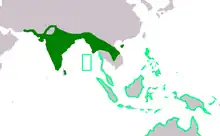Esacus
Esacus is a genus of bird in the stone-curlew family Burhinidae. The genus is distributed from Pakistan and India to Australia. It contains two species, the great stone-curlew and the beach stone-curlew.
| Esacus | |
|---|---|
 | |
| Beach stone-curlew (E. magnirostris) | |
| Scientific classification | |
| Domain: | Eukaryota |
| Kingdom: | Animalia |
| Phylum: | Chordata |
| Clade: | Dinosauria |
| Class: | Aves |
| Order: | Charadriiformes |
| Family: | Burhinidae |
| Genus: | Esacus Lesson, 1831 |
| Type species | |
| Oedicnemus recurvirostris Cuvier, 1829 | |
 | |

Taxonomy
The genus Esacus was introduced (as a sub-genus) in 1831 by the French naturalist René Lesson to accommodate the great stone-curlew.[1] The name is from Ancient Greek aisakos an unidentified bird variously associated with a robin, a shorebird or a cormorant. In Greek mythology Aesacus was a son of King Priam of Troy. Aesacus sorrowed for the death of his wife or would-be lover, and was transformed into a bird.[2]
Species
The genus contains two species:[3]
- Great stone-curlew, or great thick-knee (Esacus recurvirostris)
- Beach stone-curlew, or beach thick-knee (Esacus magnirostris)
Description
The two species are larger and heavier-set than the stone-curlews of the genus Burhinus. They resemble small bustards, especially in flight, and have long and heavy bills and long legs.[4]
Distribution and habitat
The beach stone-curlew is found in coastal areas, as its name suggests, seldom found far from the coast. The great stone-curlew also favours water, often found close to large lakes or on the river shore. Like the Burhinus stone-curlews the great stone-curlew is nocturnal, but the beach-stone curlew is less so, and feeds during the day on beaches and islands.[4] The beach curlew is found from the Andaman Is through Indonesia to Australia and New Caledonia.[5] The great stone-curlew is found from coastal Iran and Pakistan through central India, Burma, Thailand to Hainan in China.[6]
Behaviour
They feed on crabs and other invertebrates; the great stone-curlew uses its large bill to overturn stones to find prey, and the beach stone-curlew uses its bill to break up crabs and eat them, which it catches by stalking them like a heron.[4]
The Esacus stone-curlews make harsh wailing calls. The great stone-curlew is a seasonal breeder, timing it before the start of the monsoon. The timing of the beach stone-curlew is more variable across its large range.[5] The beach stone-curlew is the only member of the family not to lay a clutch of two or three eggs, and lays a single egg.[4]
Status
Both species are listed as near threatened by the IUCN. They are threatened by habitat loss, introduced predators and disturbance of their breeding habitat.[5][6]
References
- Lesson, René (1831). Traité d'Ornithologie, ou Tableau Méthodique (in French). Vol. Livraison 7. Paris: F.G. Levrault. p. 547. Published in 8 livraisons between 1830 and 1831. For dates see: Dickinson, E.C.; Overstreet, L.K.; Dowsett, R.J.; Bruce, M.D. (2011). Priority! The Dating of Scientific Names in Ornithology: a Directory to the literature and its reviewers. Northampton, UK: Aves Press. p. 119. ISBN 978-0-9568611-1-5.
- Jobling, James A. (2010). The Helm Dictionary of Scientific Bird Names. London: Christopher Helm. p. 151. ISBN 978-1-4081-2501-4.
- Gill, Frank; Donsker, David; Rasmussen, Pamela, eds. (January 2021). "Buttonquail, thick-knees, sheathbills, plovers, oystercatchers, stilts, painted-snipes, jacanas, Plains-wanderer, seedsnipes". IOC World Bird List Version 11.1. International Ornithologists' Union. Retrieved 1 June 2021.
- Hume, R. & Bonan, A. (2017). Thick-knees (Burhinidae). In: del Hoyo, J., Elliott, A., Sargatal, J., Christie, D.A. & de Juana, E. (eds.). Handbook of the Birds of the World Alive. Lynx Edicions, Barcelona. (retrieved from http://www.hbw.com/node/52241 on 12 March 2017)
- Hume, R., Kirwan, G.M. & Boesman, P. (2017). Beach Thick-knee (Esacus magnirostris). In: del Hoyo, J., Elliott, A., Sargatal, J., Christie, D.A. & de Juana, E. (eds.). Handbook of the Birds of the World Alive. Lynx Edicions, Barcelona. (retrieved from http://www.hbw.com/node/53774 on 12 March 2017).
- Hume, R. & Kirwan, G.M. (2017). Great Thick-knee (Esacus recurvirostris). In: del Hoyo, J., Elliott, A., Sargatal, J., Christie, D.A. & de Juana, E. (eds.). Handbook of the Birds of the World Alive. Lynx Edicions, Barcelona. (retrieved from http://www.hbw.com/node/53773 on 12 March 2017).